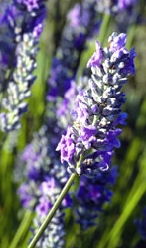
Culinary Discovery
For the Love of Lavender: Celebrate the beauty, scent and taste of lavender
Lavender's subtle and stimulating aroma is one the world's most adored and sought after. Its fragrance is soothing, romantic, nostalgic and healing. Lavender is indigenous to the Mediterranean region and a member of the mint family. This delicately beautiful flowering herb has been prized throughout the centuries dating back to the Egyptians.
The Romans used the oils to treat a wide range of maladies and to scent their baths. The word lavender is derived from the Latin term to wash, lavare. As the Romans expanded their empire across Europe, they brought the lavender with them. Since it grows heartily in a wide range of climates they were able to ensure its propagation.
The Europeans quickly embraced it as their own and continued to grow and use it well after the Roman Empire fell. The European soap makers who used lavender extensively in their hard milled soaps in the 18th century are a great example of that fact. Today, lavender is used in fine linen and bath products as well as in aromatherapy to soothe anxiety and headaches. In addition, it is used as a moth repellant, a disinfectant, deodorant, and to soothe skin irritations. Supplying that passion for lavender does not come easily as 250 pounds of buds are needed to make two cups of essential oil.
Most people think that lavender is only to be used in the bath, laundry and for aromatherapy. Make sure that you cook with culinary organic lavender and not lavender used for crafts and potpourri as that form may be treated with chemicals. Culinary lavender is a delicious edible herb just like thyme, oregano and basil are. All parts of the lavender can be used including the stems which can be thrown into coals of the grill to add a lavender smoky flavor to foods. Fresh and dried buds can be used just like other herbs are used. A terrific alternative to mint and rosemary, lavender is quite versatile when used in a multitude of courses such as savory and sweet dishes; on meats, fruits, infused in cream and with citrus.
An easy way to start using lavender is to cook with Herbes de Provence; a commonly used in the French spice mixture Herbes de Provence. The herb mixture includes: marjoram, thyme, rosemary, fennel, savory, basil and lavender. Herbes de Provence is a perfect blend of herbs and with a few pinches it flavors many vegetable and meat dishes deliciously. For example it is delicious in sautéed zucchini, in vegetable soups, in scalloped potatoes, and on roasted meats and fish, infused in olive oil, and in omelets.
The Europeans, the French in particular, have used lavender in their cuisine for centuries. Lavender grows in abundance in the Provence region of France and is used in many of their regional dishes. The French sent their lambs to graze in lavender fields so that their meat would be sweet. Lavender honey is also found all over the south of France; bees collect the nectar of the lavender flowers and make a subtlely delicious honey.
Lavender was introduced into England in the 1600's. Since the Tudor era, the English have used lavender in teas and various sweet dishes; Queen Elizabeth I loved lavender jelly. Lavender has now found its way into many kitchens of great chefs across the United States, especially since edible flowers have gained popularity as a way to enhance both the flavor and look of the food.
Lavender Recipes:
Lavender Coconut Flan
Steak with Lavender Thyme Butter
Cod with Lavender and Miso
Foccacia with Lavender and Garlic
Chicken with Lavender and Lemon
Reluctant Housewife Culinary Discovery Articles
Blog Food Events, Reluctant Housewife Recipes

No comments:
Post a Comment